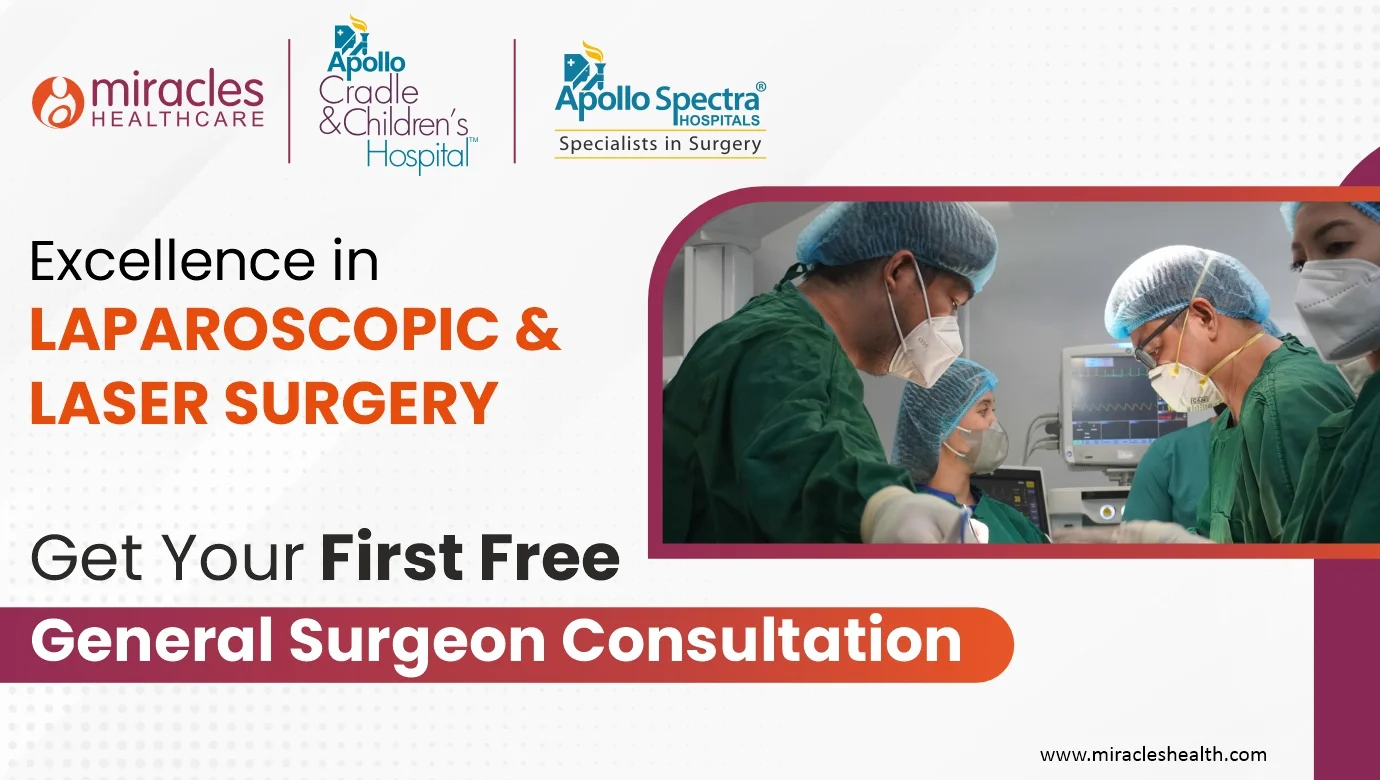General Surgery Conditions We Treat
Comprehensive Care for Your Health

Laparoscopic hernia repair is a minimally invasive surgical technique used to fix hernias through small incisions with the help of a Laparoscope (a thin, lighted tube with a camera on the end) and specialized instruments. It involves inserting a mesh to support the weakened area of the abdominal wall, reducing recovery time and post-operative pain compared to traditional open surgery. This approach offers advantages such as shorter hospital stays, quicker return to normal activities, and lower risk of complications.
Hernia operation laparoscopic surgery is a surgical approach to repairing hernias, which are bulges of organs or tissues through weakened spots in the abdominal wall. In this technique, a surgeon makes several small incisions in the abdomen through which a camera and specialized instruments are inserted. The camera provides a clear view of the hernia and surrounding tissue on a monitor, allowing the surgeon to perform the repair with precision.
During the procedure, the hernia sac is pushed back into place, and a mesh patch is placed over the weakened area to support it. The mesh is secured in position with sutures, or staples. Compared to traditional open surgery, laparoscopic hernia repair offers several advantages, including reduced post-operative pain, shorter recovery time, smaller scars, and lower risk of complications such as infection and hernia recurrence. Patients typically experience faster return to normal activities and have shorter hospital stays.
Laparoscopic hernia repair is required to treat hernias. This surgical technique is recommended for several reasons including:
Minimally Invasive: Compared to traditional open surgery, laparoscopic hernia repair involves smaller incisions, resulting in reduced pain, less tissue trauma, smaller scars, and faster recovery.
Reduced Risk of Complications: Compared to traditional open surgery, laparoscopic surgery generally has a lower risk of complications such as infection, bleeding, and wound herniation.
Shorter Recovery Time: With laparoscopic hernia repair, patients experience a quicker recovery, allowing them to return to normal activities shortly.
Lower Risk of Recurrence: The use of mesh to support the weakened abdominal wall during laparoscopic repair reduces the risk of hernia recurrence.
The right candidate for hernia operation laparoscopic surgery typically includes individuals who:
Ultimately, the decision for hernia operation through laparoscopy should be made in consultation with a qualified hernia surgery doctor who can evaluate the individual's specific circumstances and recommend the most appropriate treatment approach.
To prepare for a laparoscopic hernia operation, consider the following steps:
Consultation with a general surgeon: Schedule an appointment with a surgeon specializing in laparoscopic hernia repair. During this consultation, a laparoscopic surgery expert will assess your medical history, perform a physical examination, and discuss the procedure, potential risks, and benefits with you.
Pre-operative tests: Your surgeon may order pre-operative tests such as blood tests, Ultrasound or MRI scan, and electrocardiogram (ECG) to ensure you are in good health for surgery.
Medication review: Inform your surgeon about any medications, supplements, or herbal remedies you are taking, as some medications may need to be adjusted or stopped before surgery.
Quit smoking: If you smoke, ceasing smoking several weeks before surgery can help reduce the risk of complications and promote better healing.
Follow pre-operative instructions: Your surgeon will provide specific instructions to prepare for surgery, which may include fasting for a particular period before the procedure and showering with special antibacterial soap.
By following these steps in consultation with your surgeon,you may effectively prepare yourself for hernia operation through laparoscopy and optimize your surgical outcome.
Laparoscopic hernia repair is typically performed under general anesthesia and involves the following steps:
Small incisions: The surgeon makes several small incisions in the abdominal wall, typically ranging from 0.5 to 1.5 centimeters in length.
Insertion of trocars: Trocars are hollow tubes, which are inserted through the incisions and serve as ports for the laparoscopic instruments and camera.
Visualization: A laparoscope is inserted through one of the trocars, providing the surgeon with a broad view of the abdominal cavity on a monitor.
Hernia identification: The surgeon identifies the hernia and its surrounding structures, such as the intestines or blood vessels, that may need to be repositioned during the repair.
Reduction of hernia: Using laparoscopic instruments, the hernia sac is gently pushed back into the abdominal cavity.
Mesh placement: A synthetic mesh patch is then placed using sutures, staples, or tissue glue over the weakened area of the abdominal wall to support it and prevent the hernia from recurring.
Closure: Once the mesh is securely positioned, the surgeon removes the laparoscopic instruments and trocars, and the small incisions are closed with sutures or surgical tape.
Laparoscopic hernia operation offers several advantages over traditional open surgery:
Minimally invasive: Laparoscopic surgery involves smaller incisions compared to open surgery, resulting in less trauma to the surrounding tissues and reduced postoperative pain.
Faster recovery: Patients undergoing laparoscopic hernia repair generally experience faster recovery and can return to normal activities sooner compared to open surgery.
Reduced risk of complications: Laparoscopic surgery is associated with a lower risk of complications such as infection, bleeding, and wound herniation compared to open surgery.
Minimal scars: The small incisions used in laparoscopic hernia repair result in minimal scars compared to the larger incisions required in open surgery, offering better cosmetic outcomes.
Shorter hospital stay: Many patients undergoing laparoscopic hernia repair are discharged after a short hospital stay, leading to reduced surgery costs and improved patient satisfaction.
Lower risk of hernia recurrence: The use of mesh to support the weakened abdominal wall during laparoscopic repair reduces the risk of hernia recurrence compared to non-mesh repairs.
Improved visualization: Laparoscopic surgery provides the surgeon with an enhanced view of the surgical field using a camera inserted through a laparoscope, allowing for better visualization and precision during the procedure.
Overall, laparoscopic hernia repair offers multiple advantages, making it a preferred choice for many patients and surgeons alike. However, the benefits may vary depending on factors such as the patient's condition, the type and size of the hernia, and the surgeon's experience and expertise with laparoscopic techniques.
After laparoscopic hernia repair, patients can expect the following:
Pain and discomfort: Some degree of pain and discomfort around the incision sites is common after laparoscopic hernia surgery. This can usually be managed with over-the-counter pain medications or prescription pain relievers as prescribed by the surgeon.
Activity restrictions: Patients are generally advised to avoid strenuous activities, heavy lifting, and driving for a particular period after surgery to allow for proper healing of the abdominal muscles and incisions.
Swelling and bruising: Swelling and bruising around the incision sites may occur but usually fix within a few days to weeks after surgery.
Diet: Patients may be instructed to follow a soft or liquid diet for the first few days after surgery to minimize discomfort and help in digestion. Gradually, they can resume their normal diet as tolerated.
Return of bowel function: It is normal for bowel movements to be temporarily impacted after surgery due to factors such as anesthesia and changes in diet. Bowel function naturally returns to normal within a few days after surgery.
Follow-up appointments: Patients will have follow-up appointments with their surgeon to monitor their recovery, remove any sutures or surgical tape, and address any concerns or complications that may arise.
Gradual return to activities: Patients can slowly increase their level of activity as tolerated, starting with light activities such as walking and gradually progressing to more strenuous activities over time.
Wound care: Patients should follow any specific wound care instructions provided by their surgeon, which may include keeping the incision sites clean and dry, avoiding soaking in water, and changing dressings as needed.
It's important for patients to closely follow their surgeon's post-operative instructions to ensure a smooth recovery and optimal outcome after laparoscopic hernia repair.
After hernia repair laparoscopic surgery, it's essential to follow your surgeon's instructions for proper post-operative care. Following these care instructions carefully can help promote a smooth recovery and optimize the outcome of your laparoscopic hernia repair.
Here are some general care guidelines:
Monitor Incision Sites: Keep a close eye on the incision sites for any signs of infection such as swelling, increased redness, warmth, or drainage. If you experience any unusual symptoms, report to your surgeon.
Wound Care: Follow your surgeon's instructions for wound care, which may include keeping the incision sites clean and dry, changing dressings as directed, and avoiding soaking in water until suggested by your surgeon.
Pain Management: Take prescribed pain medications or over-the-counter pain relievers to manage post-operative pain.
Activity Restrictions: Follow your surgeon's guidance on activity restrictions. Avoid lifting heavy objects, strenuous activities, and driving until advised by your surgeon.
Diet: Gradually transition back to your regular diet as tolerated. Initially, you may be advised to follow a soft or liquid diet to minimize discomfort and aid in digestion.
Hydration: Drink plenty of fluids to stay hydrated, which can help with recovery and bowel function.
Bowel Movements: It's normal for bowel movements to be affected temporarily after surgery. Eat a high-fiber diet, drink plenty of fluids, and stay active to help prevent constipation. If needed, your surgeon may recommend stool softeners or laxatives.
Follow-up Appointments: Attend all scheduled follow-up appointments with your surgeon to monitor your recovery progress, remove any sutures or surgical tape, and address any concerns or complications.
Gradual Return to Activities: Gradually increase your activity level as tolerated, starting with light activities such as walking and gradually progressing to more strenuous activities over time.
Avoid Smoking: If you smoke, avoid smoking as it can impair healing and increase the risk of complications. Quitting smoking before and after surgery can promote better outcomes.
Notify Your Surgeon: Inform your surgeon immediately if you experience severe pain, fever, constant nausea or vomiting, or any other concerning symptoms.
While laparoscopic hernia repair is generally considered safe, like any surgical procedure, it carries certain risks and possible complications. These may include:
Infection: There is a risk of developing an infection at the surgical site or within the abdominal cavity. This risk is generally low but can occur even with precautions taken during surgery and post-operative care.
Bleeding: Bleeding can occur during or after surgery, leading to blood clot formation or requiring additional interventions to control bleeding.
Damage to surrounding organs: During the procedure, there is a small risk of unintentional injury to nearby organs such as the intestines, blood vessels, or nerves. This risk is minimized by the careful use of laparoscopic visualization.
Mesh-related complications: The use of mesh to support the abdominal wall carries a risk of complications such as mesh migration, mesh shrinkage, or adhesion formation. These complications can sometimes lead to chronic pain or discomfort.
Chronic pain: Some patients may experience chronic pain or discomfort following hernia repair, which can be attributed to nerve damage, scar tissue formation, or mesh-related complications.
Hernia recurrence: While the use of mesh during laparoscopic repair reduces the risk of hernia recurrence, it does not eliminate it. Recurrence can occur due to factors such as mesh failure, inadequate mesh placement, or underlying issues with tissue healing.
Anesthesia risks: General anesthesia carries its own set of risks, including allergic reactions, respiratory issues, or adverse reactions to anesthesia medications. These risks are typically low but can vary depending on individual health factors.
Pneumoperitoneum-related complications: The abdominal swelling with carbon dioxide gas during laparoscopic surgery can lead to complications such as respiratory issues, subcutaneous emphysema, or gas embolism.
Thromboembolism: There is a risk of developing blood clots following surgery, especially in patients with pre-existing risk factors such as obesity, immobility, or a history of blood clotting disorders.
Impaired bowel function: Following surgery, temporary impairment of normal bowel function may occur, leading to symptoms such as bloating, abdominal distension, and delayed passage of stool or gas.
Before undergoing hernia repair laparoscopic surgery, it's important to discuss these risks with your surgeon and follow all pre-operative and post-operative instructions carefully to minimize the chance of complications.
Several factors can influence the cost of laparoscopic hernia repair. So, patients need to discuss the expected costs with their surgeon and insurance provider beforehand.
Here are some factors affecting the cost including:
Type and Complexity of Hernia: The type, size, and complexity of the hernia being repaired can affect the cost of surgery. Larger or more complex hernias may require additional time, resources, and expertise, leading to higher costs.
Use of Mesh: If mesh reinforcement is used during hernia repair, the cost of the mesh material itself may be a factor in the overall cost. Additionally, the type and brand of mesh used can also affect the cost.
Hospital or Surgical Facility Fees: The cost of the hospital or surgical facility, including operating room fees, and recovery room charges. These charges may vary based on factors such as location, facility type, and amenities.
Surgeon's Fees: The surgeon's fees for performing the procedure will depend on their experience, expertise, and geographical location.
Anesthesia Fees: The cost of anesthesia services, including the type of anesthesia used (general or regional anesthesia) and the duration of anesthesia administration, can affect the overall cost.
Pre-operative Tests and Evaluations: The cost of pre-operative tests and evaluations, such as blood tests, imaging scans, and electrocardiogram (ECG) may be included in the total cost.
Post-operative Care and Follow-up Visits: The cost of post-operative care including wound care supplies, pain medications, and physiotherapy and follow- up visits with the surgeon should be considered.
Insurance Coverage: The extent of insurance coverage can also impact out-of- pocket expenses for the patient. Some insurance plans may cover all or part of the cost of laparoscopic hernia repair, while others may require the patient to pay a portion of the expenses.
Additional Complications or Procedures: If any complications arise during surgery or post-operative recovery that require additional interventions or procedures, such as re-operation or treatment for infection, these can increase the overall cost.
Miracles Apollo Cradle/Spectra is the best hospital for Laparoscopic Hernia Repair in Gurgaon. We offer top-notch treatment for hernia problems. Our dedicated team of highly experienced general surgeons specializes in laparo hernia surgery, ensuring that you receive the most advanced and effective care. With a focus on precision and expertise, we provide comprehensive care from consultation to recovery, offering the benefits of smaller incisions, reduced pain, and faster healing.
If you are in search of the best general surgeon for hernia surgery near you, contact us and schedule an appointment with our expert.


Comprehensive Care for Your Health
Meet our expert team of General Surgeon where compassionate care meets expertise.
Inspiring Journeys: True Patient Stories
Miracles Apollo Cradle is a leading Maternity Hospital Gurgaon. We strive to give the best care to our patients.






Your Health, Our Network: Comprehensive Care Across Every Facility.
Learn about the world class health care we provide
Expert Advice and Health Tips
Learn about the world class health care we provide
Laparoscopic hernia repair is generally considered safe, but like any surgery, it carries risks such as infection, bleeding, and complications related to anesthesia.
Most patients can resume normal activities within 1-2 weeks after laparoscopic hernia repair.
Potential disadvantages include higher costs, longer operative times, and a steeper learning curve for surgeons compared to open hernia surgery.
Hernia repair is considered a common but important surgery, and when done laparoscopically, it is minimally invasive with faster recovery and fewer complications.
Miracles Apollo Cradle/Spectra is the best hospital for hernia surgery in Gurgaon, known for its advanced laparoscopic techniques and highly experienced surgeons.
Various types of hernias including inguinal, umbilical, and incisional hernias can be treated with laparoscopic hernia repair.
Laparoscopic hernia repair is a minimally invasive surgical technique that involves using small incisions and a camera to repair hernias with mesh reinforcement.
The cost of laparoscopic hernia surgery can vary widely depending on factors such as the surgeon's fees, facility charges, and insurance coverage.
Most patients recover within 1 to 2 weeks after laparoscopic surgery, while full recovery from open hernia repair may take 3 to 4 weeks.